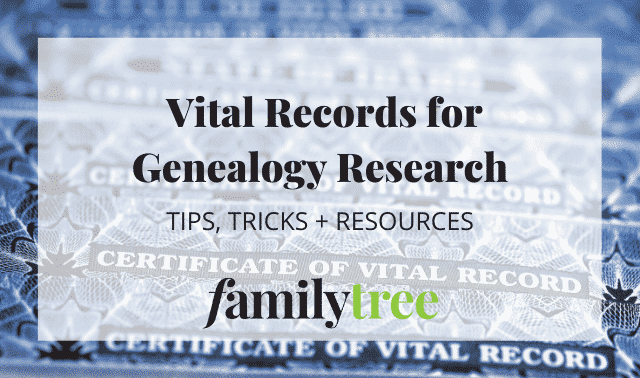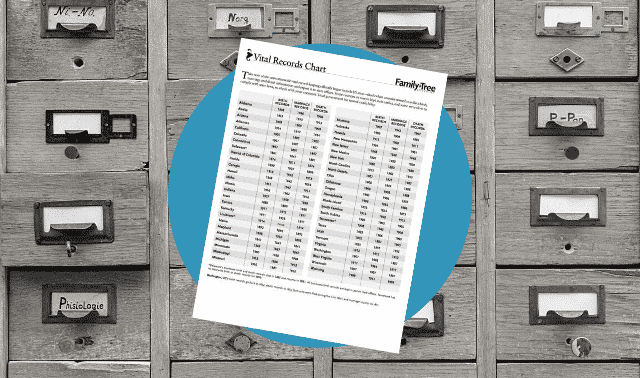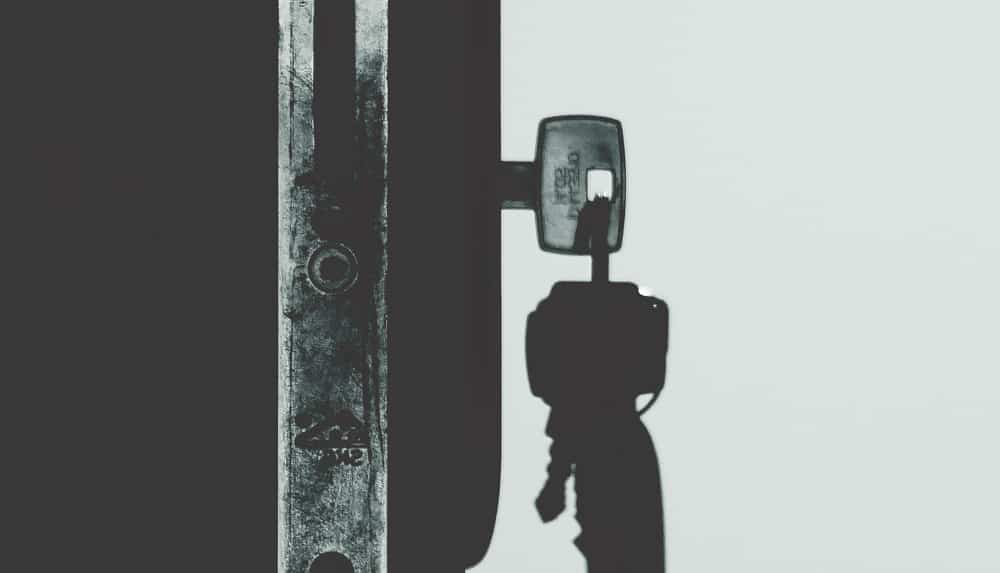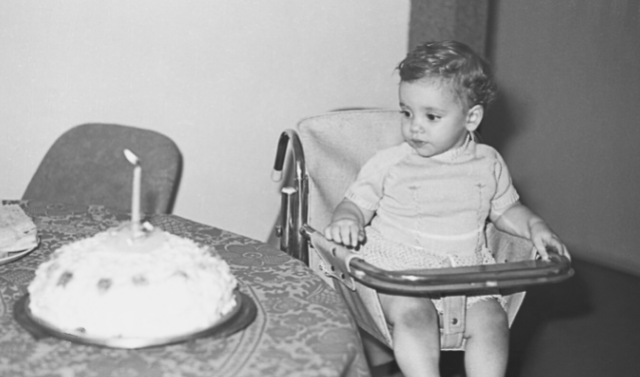Sign up for the Family Tree Newsletter Plus, you’ll receive our 10 Essential Genealogy Research Forms PDF as a special thank you!
Get Your Free Genealogy Forms
"*" indicates required fields

In the orderly, online-centric 21st century, we take certain things for granted: Your mom will be on Facebook. That missed episode of your favorite show will be available to stream. And the records of life’s milestones—birth, marriage, death—will be neatly documented and filed away at a state office.
Alas for genealogists, it ain’t necessarily so. The reality of state vital records research resembles the Wild West more than it does the modern world, with a confusing patchwork of starting dates, accessibility restrictions and gaps. Some information on getting vital records is on sites such as VitalRec.com, in FamilySearch’s wiki pages and at the National Center for Health Statistics. But for this article, we visited all 50 state vital records office websites (plus DC and Puerto Rico) to gather the most up-to-date answers on what you can and can’t get from state sources. In many cases, we discovered that those other sources are out of date or simply wrong.
Don’t confuse these official state resources with county, city or town vital records, which often began earlier than statewide registration. The online databases you’re accustomed to searching often mix county and even church records with state vital records. Although you’ll find this blending in some of the sources on our chart, we’re focusing on state-level records and what you can get from state vital records offices (or state archives, when early records have been transferred there).
The ability to fill out your family tree with state vital records depends on two key variables: timing and access. The best states for genealogy research deliver on both, or really excel on one or the other. If your family comes from a state that was late to adopt statewide registration and restricts access to what it does have (we’re looking at you, Mississippi and New Mexico), you may need to turn to county, church and other sources.
Late starts and gaps in vital records
Let’s first consider timing. While a few states, such as Massachusetts and New Jersey, began keeping comprehensive birth, marriage and death records in the mid-19th century, most held off until the early 20th century. A few states didn’t require marriage records until the 1960s. (In many states, marriages continue to be a county-only registration; other states rely on county clerks for marriage records, but keep copies at the state level.) That doesn’t mean no earlier records exist—only that you need to consult county offices or the state archives for them.
Even when a state started “requiring” vital records, however, that doesn’t mean everybody complied. If only all states were like Oregon on this score, where the date of “general compliance” is the same as the start of statewide records—1903 for births and deaths, 1906 for marriages. Too many are more like Oklahoma, where it was 20 years before almost every birth and death was on record at the state level. Or Rhode Island, where “mandated” statewide vital records began in 1853, but “general compliance” happened only in 1915.
Other states have bureaucratic gaps. Ohio, for example, began statewide death registration in 1908, but its vital statistics office maintains death records only from 1964 and forward. If you turn to the online records at Ancestry, you can find Ohio death registrations from 1908 to 2007—but the coverage is incomplete or missing for 1933 to 1937 and 1952 to 1955.
Come and get ’em
Even when the certificates exist, genealogists might not be allowed to access them. These restrictions also vary by state with some “open” access, others “closed” completely, and still others somewhere in between. Concerns over privacy and identity theft have overwhelmed research interests in recent years, with a flurry of restrictions slamming the door on genealogists.
In mostly “open” states, you may be able to get only a non-certified, “informational” copy of a record, which you can’t use for official purposes but is usually sufficient for genealogy. Other states redact details such as cause of death and Social Security number on informational death certificates.
Know the available years
Most “closed” states limit access for 25 to 125 years—usually longer for births than for marriages or deaths—with exceptions for certain requestors. That’s usually the person named in the record or the person’s parents, spouse, children, grandchildren, siblings or grandparents (or their legal representatives). Proof of the relationship may be required. Some states add exceptions for those with a “legitimate interest,” typically means inheritance or other financial stake. Even if you qualify to order a restricted death certificate or a birth certificate of a deceased person, you might have to send proof the person named has died—pretty tricky, since death evidence is what you’re trying to obtain.
Order online when possible
Try to order online, either via the state website or VitalChek. Most states report faster response times for electronic orders. Mail and telephone orders can take several weeks, and some states assign lower priority to genealogical requests. (The wait times reported on our chart are for mailed requests, without “expedited” options.) When ordering by mail, you can save time by filling out an online request form, if available. Fees vary, but generally run $10 to $30.
Online birth, marriage and death indexes can help you fill in the forms. See our chart for resources. Some indexes contain all the data shown on the actual certificate, or link to images of the records. Note that because online databases may combine records from state and other sources, finding an ancestor in an index doesn’t necessarily mean the state has a record.
What can you learn?
When you can overcome the obstacles of timing and accessibility, the research rewards of official vital records can be well worth the effort. On an Arizona birth certificate, for example, you’ll learn the child’s birth date and place, and each parent’s age, birthplace, occupation and race. A Delaware marriage record gives the date and place, each spouse’s name, age, race, address, occupation, birthplace, prior marital status, parents’ names and birthplaces. Kentucky’s death certificates include the cause, date and place of death, the deceased’s birth date and place, gender and race, marital status and spouse’s name and age, and both parents’ names (including mother’s maiden name) and birthplaces, plus burial information.
Delayed birth records
Don’t overlook the possibility that an ancestor born too early for an official state birth certificate applied for a “delayed” one as an adult, often when registering for Social Security or a pension plan. Delayed birth records may be filed and requested similarly to or apart from standard records, but usually contain a similar wealth of information.
If you’re stumped
Just because you can’t obtain a state vital record—whether it doesn’t exist or access is restricted—doesn’t mean you’ll never find evidence of your relative’s birth, marriage or death. Don’t forget that county or town vital records typically began years before states got into the act. In New England, town vital records stretch back to colonial times. These early records may be online. Start your search on the free FamilySearch, then explore subscription sites and the volunteer-created county resources at USGenWeb.
Additional options
Church records also can take the place of state vital records. Newspaper birth and marriage announcements, as well as obituaries, often can fill in the blanks in your tree. You might even find the information you need right under your nose: Family members may have tucked away copies of these important documents in desk drawers, Bibles and lockboxes. Next time you’re on Facebook, ask Mom.
Last updated, January 2023
A version of this article appeared in the October/November 2018 issue of Family Tree Magazine.
Related Reads
ADVERTISEMENT










